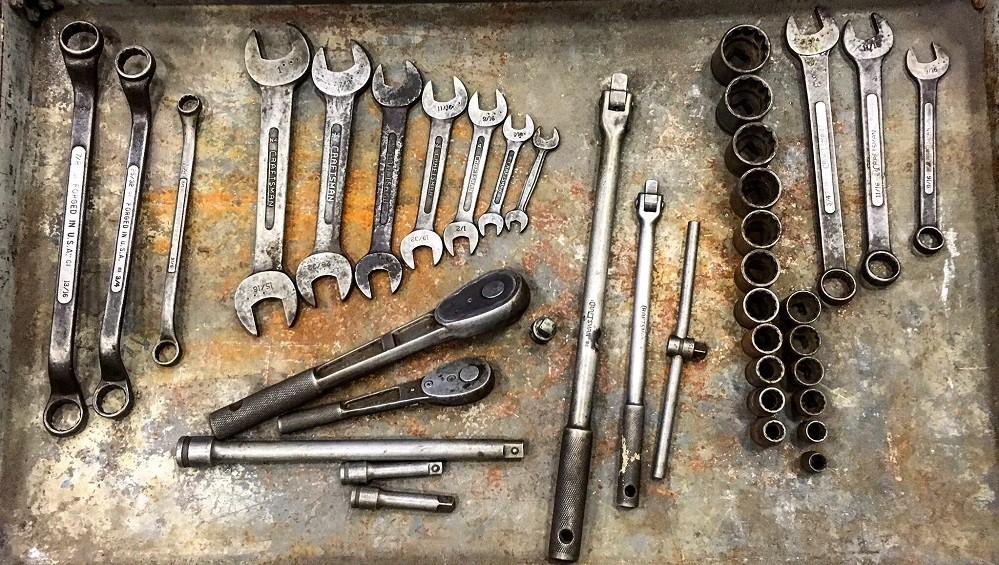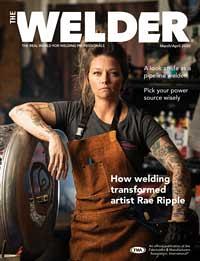Owner, Brown Dog Welding
- FMA
- The Fabricator
- FABTECH
- Canadian Metalworking
Categories
- Additive Manufacturing
- Aluminum Welding
- Arc Welding
- Assembly and Joining
- Automation and Robotics
- Bending and Forming
- Consumables
- Cutting and Weld Prep
- Electric Vehicles
- En Español
- Finishing
- Hydroforming
- Laser Cutting
- Laser Welding
- Machining
- Manufacturing Software
- Materials Handling
- Metals/Materials
- Oxyfuel Cutting
- Plasma Cutting
- Power Tools
- Punching and Other Holemaking
- Roll Forming
- Safety
- Sawing
- Shearing
- Shop Management
- Testing and Measuring
- Tube and Pipe Fabrication
- Tube and Pipe Production
- Waterjet Cutting
Industry Directory
Webcasts
Podcasts
FAB 40
Advertise
Subscribe
Account Login
Search
The souls and stories behind everyday metalworking tools
Old manufacturing buildings converted into lofts can still tell a story
- By Josh Welton
- March 21, 2020
- Article
- Arc Welding

There’s something special about a century-old building, tools that have shaped some of history’s most prolific projects, or even the items once used by family or mentors. Photos by Josh Welton
The idea of inanimate industrial objects having a soul has always fascinated me. Tools, automobiles, and buildings: Can they be more than the sum of their parts? For example, a vintage wrench—what past craftsman held it like an extension of his arm while performing his daily tasks? An old farm truck that smells like oil, gasoline, and metal and now brings a smile to all it chugs past. Walking through an abandoned factory in Detroit, an army of workers whose blood and sweat soaked into the wooden floor rise up to meet the dust falling from the overhead beams to cast ghosts still working overtime.
I suppose that this concept of “soul” should be defined, although perhaps its essence will skirt around any solid delineation. Humans think of our soul as being separate from our physical body, yet anchored to our mind and heart. It is what gives life to our literal self and drives us to find meaning in existence.
But what if your soul isn’t necessarily tied down to skin and bones? What if everything you touch or craft with purpose absorbs a little part of your soul? What is to say that when we put our mind, heart, and body into a project we aren’t also leaving a bit of our life with it?
The feeling I get when I explore a century-old building, whether it’s empty and rundown, still in use or repurposed, is difficult to explain. The phrase “If these walls could talk” seems apt, while at the same time I think they do talk to those willing to listen. It takes a kindred spirit to feel the weight of an object’s history.
Here in Detroit, old factories that have been converted into industrial lofts are en vogue, and it’s frustrating to see how many of them are just, well, sterile. Their developers obviously aren’t tuned in to this wavelength I’m speaking of, and they build out like they’re constructing a completely new space from the ground up. As an example, I was superstoked to check out the “modern industrial” Willys Overland Lofts conversion, housed in a four-story building that used to be a sales and service center. It even hosted the Detroit Auto Show in 1918. But when we toured the Willys building, it had basically been turned into luxury apartments with only the exterior hinting at its rich history.
The loft that I live in sits on the other end of the spectrum. It is part of the old Crescent Brass and Pin Co. building, a century-old factory that exudes character. The developers listened to the vestiges of the shop’s past and built around them to accentuate voices rather than quiet them. Our unit has two old fire doors, a couple of martini columns, and brick walls everywhere. You can look at the walls and ceiling and see marks and holes where things were mounted and hung. Outside in the entryway is the only surviving machine—a press used to create a proprietary part. The address still holds the patent for the first self-sealing roofing nail. It’s a cool space and maintains the spirit of a city’s former self.
It was a gut punch when my shop was robbed in 2016. Not because I was out tens of thousands of dollars in tools, but because of what the thieves took: Tools that I’d collected over the previous 15 years. Tools with which I learned my trade. Machines that built my business. My Dynasty 200, the first welder I’d purchased, the one I’d spent thousands of hours with in my old shop, the one I was going to give to my dad to hold on to. An entire drawer of Channellocks, all with burn-marked handles and broken-in grooves. A collection of hammers (I love my hammers). A horizontal saw my wife gave me. The list goes on and on. Most of the tools could be replaced, but that intrinsic quality of kinetic energy, that connection between me and those objects, could not.
My dad recently gave me his first pair of vise grips and a rolling head pry bar, which he used when he was a teenager to build a pair of dune buggies with my uncle. “Don’t lose them!” was the only string attached. I can just barely remember riding in that blue buggy he built, and I remember when he traded it in for an amphibious vehicle that freaked my mom out when we took it out in the swamp! Anyways, somehow these tools hold a little bit of my dad’s magic from the mid ‘70s, right before I was born. Hopefully I can do them justice.
Collecting old tools, even ones with unknown backgrounds, still stokes my imagination. I have a set of well-worn wrenches, ratchets, and sockets that were made sometime between 1931 and 1947. Did they work on a ‘32 Ford, an M4 tank, or maybe the machines that made them? I don’t know. Whatever they did, they’re now in my hands and it’s my duty to breathe new life into them. At the same time I scored that set I also acquired a well-used 133-lb. Trenton anvil from 1900. It was around before Henry Ford and the Dodge brothers built the first Model A! I don’t use it much, but I feel better just knowing it’s a couple feet away while I work.
I’m not going to exclude new things, either, like my car, a 2018 Dodge SRT Demon. It’s a serialized limited production car, and I got number 40 because I turned 40 in 2018. I was able to attend the car’s unveiling in New York, and it sunk its claws into me. Many of my friends worked on the car’s design and development, and I know the energy and passion they put into this crazy 840-HP beast. It has a unique suspension setup for racing and the tires at all four corners are superwide, barely street-legal drag radials. An unintended consequence of this is that it rides like an old-school Cadillac, which I love.
There’s no sound deadening and no rear seat to save weight, so you hear everything. The supercharger’s whine is glorious, the fuel injectors click loudly, and the exhaust roars, a glorious instrument of sound and fury. It’s a widebody car with a unique stance and the largest hood scoop ever put on a production car. My friend Mark, the head of design for the design studio that’s responsible for the Demon, calls that hood “a middle finger” to civilized society. I guess it's kind of ironic to say the Demon has soul, but it does. I feel connected every time I drop into the driver’s seat. The more miles we trek, the more of its character is revealed.
Yes, I believe that objects can have a soul, but it depends on human interaction, both what we put into a thing and what we take from a thing. I think this soul manifests itself based on how we as individuals, and a culture, interact with these objects; it takes compatible human hearts and minds to experience this metaphysical connection. And if you do, you know. Like us, the creators and makers of our universe, the material world can be more than the sum of its parts.
About the Author

About the Publication
subscribe now

The Welder, formerly known as Practical Welding Today, is a showcase of the real people who make the products we use and work with every day. This magazine has served the welding community in North America well for more than 20 years.
start your free subscription- Stay connected from anywhere

Easily access valuable industry resources now with full access to the digital edition of The Fabricator.

Easily access valuable industry resources now with full access to the digital edition of The Welder.

Easily access valuable industry resources now with full access to the digital edition of The Tube and Pipe Journal.
- Podcasting
- Podcast:
- The Fabricator Podcast
- Published:
- 04/30/2024
- Running Time:
- 53:00
Seth Feldman of Iowa-based Wertzbaugher Services joins The Fabricator Podcast to offer his take as a Gen Zer...
- Industry Events
Pipe and Tube Conference
- May 21 - 22, 2024
- Omaha, NE
World-Class Roll Forming Workshop
- June 5 - 6, 2024
- Louisville, KY
Advanced Laser Application Workshop
- June 25 - 27, 2024
- Novi, MI
Precision Press Brake Certificate Course
- July 31 - August 1, 2024
- Elgin,
































